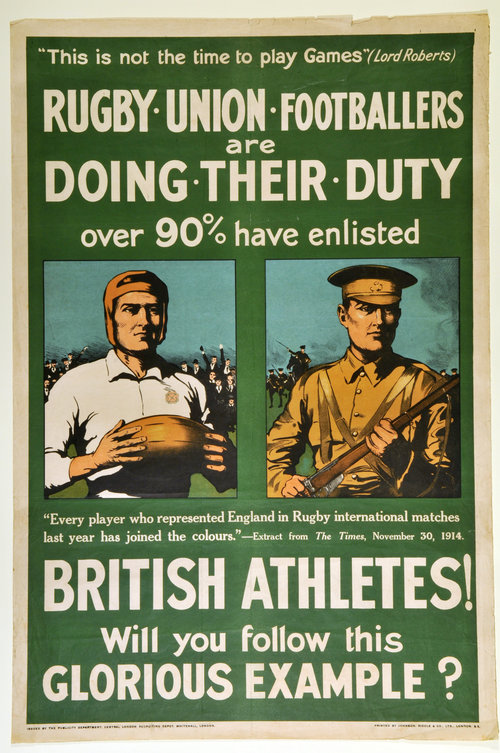Sports at War
When war broke out, professional and amateur sports were an important part of life. This continued throughout the war, as people at home and on the front line found ways to use their sporting talents to support the war effort and keep up morale.
Rugby
Many rugby players enlisted during the war. Teams often joined up together and sadly, quite often died together too. 27 England Rugby Internationals died in the First World War, and so did huge numbers of club- and school-level players. Men who enlisted took their love of rugby to the Front with them, and many tournaments were played including the Somme Cup in 1917. The ‘Trench All Blacks’, representing New Zealand, were victorious. This was actually their second victory! New Zealand also won a tournament against Australia at Gallipoli in 1915, played on a sandy beach at low tide. The New Zealanders defeated the Australians 13 tries to nil – even though there were no goals kicked as they didn’t have any goalposts! The following day, the two teams fought alongside each other against the Ottoman Empire.
Cricket
When war broke out, hundreds of amateurs playing county cricket with commissions in the Territorial Army joined their regiments, and many professional cricketers had enlisted as volunteers.
The buildings at Lord’s, Old Trafford, Trent Bridge, and the county grounds of Derbyshire and Leicestershire were used as accommodation for army units and military hospitals, and many cricket clubs allowed their grounds to be farmed to help the war effort.
Cricket continued during the war. British troops on the Western Front organised matches between regiments, or between officers and sergeants, and often charity matches took place on the Home Front to raise money for the war effort. In fact the game was even used as a decoy! While ANZAC troops were evacuating from Gallipoli, the Australians staged a huge cricket match to distract the Turkish troops. They played a match in full view of the Turks and with shells flying overhead, to make it seem like things were normal while thousands of men were being secretly evacuated from the beach by night!
DID YOU KNOW...?
Eighteen thousand hay-nets for War Horses were made at Lord’s Cricket Ground!
Football
Football has long been an important part of British culture, and was used to keep up morale at the front. At Christmas 1914 there was a truce, and soldiers set aside their weapons. It was rumoured that a game of football took place between British and German troops in No Man’s Land. Whether or not this match against the Germans really occurred, games of football on the front line were a common occurrence.
At home, women’s football became a huge sport, with crowds of 10,000 turning out to matches to raise money for war charities. In 1918 the Munitionettes Cup was held, with 30 teams competing in front of a 20,000-strong crowd and Blyth Spartans Ladies FC becoming champions!
Walter Tull
Walter Tull was born in Folkestone in 1888. His father had arrived from Barbados in 1876 and his mother was from Kent. Both of Walter’s parents died when he was still a child.
Walter was a keen footballer and in 1908 his talents were discovered by a scout from Tottenham Hotspur whom he played for until 1910 before transferring to Northampton Town.
When war was declared in 1914, Walter gave up his football career to join the 17th (1st Football) Battalion of the Middlesex Regiment.
Walter was promoted three times during his training. Whilst fighting on the Western Front in 1915, he was sent home with post traumatic disorder, but returned to fight in the Battle of the Somme in 1916. Walter’s superiors were impressed by his courage and abilities and recommended him as an officer. Even though black soldiers were officially barred from becoming officers, Walter was commissioned as a Second Lieutenant.
On 25th March 1918, Lieutenant Tull was killed by machine gun fire during an attempt to breach German lines on the Western Front. Walter’s body was never found and he is one of the thousands of soldiers from the war who have no known grave.



